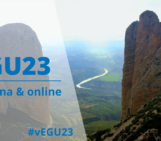
It’s no secret that at EGU we believe using film as a medium to communicate science and engage the public with research is a great tool! So much so that we organise an annual competition for early career scientists (ECS) to produce a three-minute video to share their research with the general public, as well as publishing film how-to-guides on our blog and organising film-making workshops at our General Assembly (GA).
The film-making workshops of 2014 and 2015 focused on how to make a film: from producing the script right through to aspects of editing and post-production. This year, the workshop was delivered by Stefan Ruissen, an online & cross media specialist, and centred on how scientists can raise the profile of their film work. In today’s post, we highlight some of the main points from the workshop and share Stefan’s slides with you too.
The fact that rich-media and video has grown to form an integral part of conveying a message, be it a news story, a funny meme, or capturing moments of our everyday life should not be underestimated. Harnessing the growing popularity of video when it comes to helping you tell the narrative of your research is crucial!
Video and social media
Social media channels mean that the possibilities to communicate and share the film you invested so much time in creating have multiplied. An important take-home message from the 2014 workshop was knowing your audience: whom are you producing the film for and what message do you want them to take away from it?
Knowing your audience is vitally important when getting your work out there too– where is the most likely place you’ll find your audience: Facebook, Twitter, Instagram, via a blog? Spend some time trying to work this out, both in the planning stages of film-making and once your video is ready.

Social media generates opportunities to share your film with a broad audience. Identify which channels are the best ones to reach your audience and tap into your existing networks for maximum impact.
And while social media generates so many opportunities to share your film, how people are consuming content online is also changing. In the past users would actively search for content they wanted to read about or watch; now a day, most content arrives at people’s doorsteps through algorithms curated by social media channels. This means that, not only is it important to get your film ‘out there’, you’ve also got to get it noticed.
So, once you’ve identified the best platforms to use, post the content and don’t forget to engage with your audience! Be sure to start a conversation and be part of it. You will most passionately tell your story, so use every opportunity to drum up further interest in your film.
Tips
- Get noticed in on-line searches: When planning your film, think carefully about the title and once it is finished, invest time in preparing a description text and key words
- Be prepared: Have a set of promotional materials to hand, inc. a film summary, stills from your video and a short trailer
- YouTube: simply uploading your video is not enough. Social media 101 says your film should come complete with description, a link to further information/the film page (if available) and don’t forget a catchy preview image to hook viewers
- Twitter: exploit your existing network, or spend time building links with relevant peers and organisations who can further your work. The same is true for hashtags – reach a bigger audience by tapping into # and using mentions
- Facebook: Combine all your posts with stills or a trailer of your film (that’s where that preparation of promo materials comes in handy!)
- Ask your audience: Put yourself in the shoes of your audience, how would you find new science related content? If you aren’t sure, speak to your audience, they’ll likely give you a few pointers!
Making your video isn’t the half of it: while there is no doubt that you should concentrate your efforts on planning, shooting and editing your video, save some energy to develop a strategy which will allow you to disseminate your film work effectively. For more details on how to best achieve this, why not take a look at Stefan’s presentation?
By Laura Roberts Artal, EGU Communications Officer
This blog post is based on the presentation by Stefan Ruissen at the Short Course: Scientists must film! (SC47) which took place at the 2016 EGU General Assembly in Vienna. The full presentation can be accessed here.




